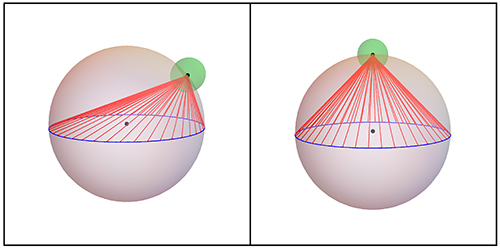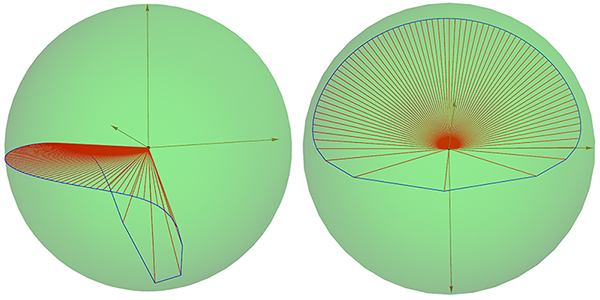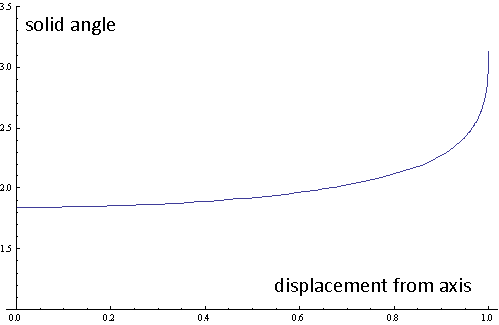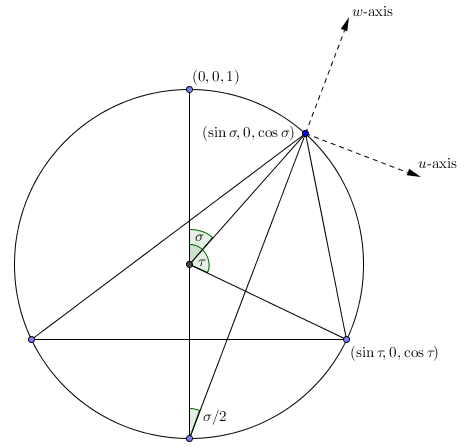Having seen the analyses presented in the other answers and Douglas Zare's comment about difficulties in visualization, I offer a view on the problem that shows how to arrive at a qualitative result (the answer to Q1 is no), and explains my confusion (expressed in a comment to Will Sawin) on why I thought a limiting value was pi steradians, then backpedaled and said it was NOT pi steradians. (The computations of Will and Douglas and further consideration support the guess I had initially: the solid angle eventually grows to pi steradians when the observer moves close to the disk.)
I initially thought of the pictures that Joseph presented as unintentionally misleading: the question asks about a projection onto a hemisphere, but not onto the hemisphere on which the observer is located, which is the prominent figure in Joseph's pictures. One has to suppress Joseph's initial illustration and replace it by one where the observer is the center of a different hemisphere; the original base is now an object to be projected on this hemisphere representing the visual field of the observer. I call this new hemisphere the "visible hemisphere".
I thought first on possible projections of the observed disk onto the visible hemisphere. It seemed that the projections would get larger primarily because one got closer to the disk edge. In fact, the disk would "block" about half the field of vision, so that would suggest a solid angle of close to pi steradians. However, when one is at the edge, one sees the disk edge on, and projects no such shadow. I also thought that the shape would resemble (but not match) that of an elongated disk approximated by an ellipse, which approached a wedge shape that covered half of the visible hemisphere.
I then tried a different model, which I called a "flap model". I chose half a disk, with its diameter oriented up and down, fixed that diameter to the apex of the visible hemisphere, and observed that the (appearance of the) diameter stayed constant (thanks to Thales), and so I always had part of the observed disk stay at the same apparent position as the observer traveled. Taking the observer's position, I moved part of the disk like a flap hinged at this diameter, and imagined that this portion grew larger as it swung closer to the observer (almost hitting the observer on their nose), but because it was a circular flap, some significant portion of the half of the hemisphere might still be visible, and also, the other half of the observed disk formed another flap that swung away from the observer and got smaller. In particular, this set up the image in my mind that I had trouble resolving with my initial thought: if the image is a projected ellipse, why is the diameter of the disk not a diameter of the projection? Since I couldn't immediately resolve this, I commented to Will Sawin about my "certainty" that the projection did not approach pi steradians in measure.
The confusion arises from common notions of perspective. (I hope Joseph takes his cue and provides some illustrations.) When one takes a rectangular region at some distance from an observer, say the face of a digital clock, and rotates it around an axis of symmetry parallel to the shorter edge of the rectangle, one gets a trapezoidal shape as a projection. (When projected to the visible hemisphere, it is a different shape, but the curves are not noticed by the observer.) If one does not have a reference line though, one assumes the axis of symmetry is placed equidistant from the bases of the apparent trapezoid. When the rectangle is far away, the actual axis is not far from the imagined axis, and so the assumption seems to hold, at least for government purposes. But in fact, the actual axis is NOT equidstant from the line equidistant from the parallel bases of the trapezoid, and in order to see this, one has to perform some calculations or some very good observations.
The disparity for circles is even less apparent: we approximate the image of a rotated disk by an ellipse. The projection however is not an ellipse, and in certain extreme cases the approximation is poor. It was such an approximation that misled me to thinking that one could not get close to pi steradians in this situation.
I finally did mentally what I should have done in real-life: I imagined holding an analog clock close to my face, and turning it until it almost hit my virtual nose. I imagined the number 12 right above the number 6, and in an elliptical projection or in a scenario where the clock is (not very) far away, the 11 and 7 are closer to me but still appear closer to each other than the 12 does to the 6. However, when the clock is about to hit my face, the 11 and 7 appear farther away than the 12 and the 6.
That the 11 and 7 will appear farther away makes sense when one places one's eye very close to the 9, and draws the lines of sight from the eye to the 12 and 6, and finds these lines run between the 11 and 7. However, and this is the key to this posting, one does not think of this image from the initial setup of Joseph's problem.
Once one has the insight that the analog clock image does distort severely even from such simple, common, and everday projective transformations, then resolution occurs: the clock does not elongate in a somewhat elliptical fashion to occupy a quadrant, instead it distorts in a way which fills the quadrant in a nonintuitive fashion not easily described. The equations in the other postings are a testament to the complexity of the descriptions of the resulting images.
While I hope that the post is clear about describing a resolution to the question, I think it more important to describe that a natural assumption about how an object appears should be subject to question, and that tests, not just analysis, of the extreme limits of such assumptions need to be made. To borrow from another MO post, multiple perspectives are very useful for resolving this problem.





